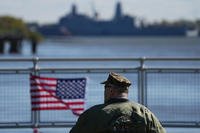President Donald Trump said in a tweet Sunday that creation of a buffer zone in northern Syria could protect the mix of Syrian Kurd and Arab Syrian Democratic Forces (SDF), backed by the U.S., from a threatened attack by Turkey.
Trump also reaffirmed his commitment to a planned withdrawal of the estimated 2,000 U.S. troops in Syria, while continuing to destroy the remnants of the Islamic State.
"Create 20 mile safe zone" in northern Syria, the president said via Twitter. "Likewise, do not want the Kurds to provoke Turkey."
Trump also said that attacking the SDF would be against Turkey's long-term interests.
"Will devastate Turkey economically if they hit Kurds," he said.
Trump gave no timetable, but said that once troop withdrawal is complete, the U.S. could attack from a base outside Syria if ISIS attempted to regroup.
"Starting the long overdue pullout from Syria while hitting the little remaining ISIS territorial caliphate hard, and from many directions," he said. "Will attack again from existing nearby base if it reforms."
Trump returned to the theme that the U.S. has borne the burden of fighting ISIS, and it is now time to withdraw.
"Russia, Iran and Syria have been the biggest beneficiaries of the long term U.S. policy of destroying ISIS in Syria - natural enemies," he said. "We also benefit but it is now time to bring our troops back home. Stop the ENDLESS WARS!"
Also on Sunday, Secretary of State Mike Pompeo said that the planned U.S. troop withdrawal from Syria amounted to a "tactical change" that would not alter the overall U.S. mission to inflict a lasting defeat on the Islamic State, counter Iran and safeguard local partnered forces.
"We have lots of tools in our arsenal," Pompeo said on CBS-TV's "Face the Nation" program. "The tactical change we've made and the withdrawal of those two thousand troops is just that -- a tactical change. Mission remains the same."
The withdrawal would be "orderly and deliberate" in accordance with the "incredibly clear" guidance from Trump, said Pompeo, a West Point graduate, former Army captain, and former CIA director.
The Dec. 19 announcement via Twitter by Trump that U.S. forces in Syria would withdraw was followed the next day by the resignation of then-Defense Secretary Jim Mattis. Trump said at the time that the troops were "coming home now," but has since said that the withdrawal would be "slow and coordinated" with allies.
The first official announcement that the withdrawal had begun came in a terse statement Friday from Army Col. Sean Ryan, spokesman for Combined Joint Task Force-Operation Inherent Resolve (CJTF-OIR), the U.S. military regional command for Iraq and Syria.
Ryan said the U.S. "has begun the process of our deliberate withdrawal from Syria. Out of concern for operational security, we will not discuss specific timelines, locations or troop movements."
The Syrian Observatory for Human Rights, the London-based monitoring group that has activists on the ground in Syria, reported several U.S. armored vehicles and trucks had pulled out of northeastern Syria and crossed into Iraq.
Later Friday, Navy Cmdr. Sean Robertson, a Pentagon spokesman, said in a statement, "The withdrawal is based on operational conditions on the ground, including conversation with our allies and partners, and is not be subject to an arbitrary timeline."
Robertson indicated that the withdrawal thus far has been limited to equipment.
"We will confirm that there has been no redeployment of military personnel from Syria to date," he said. "The mission has not changed. ... We will continue to work with partners and allies to ensure the enduring defeat of ISIS by sustaining military gains and promoting regional security and stability."
Since Trump's Dec. 19 withdrawal announcement, Turkey has renewed threats to launch an offensive into northeastern Syria against the Syrian Kurdish YPG (People's Protection Units), the main fighting force within the U.S.-backed SDF.
The SDF, with U.S. air and artillery support, has liberated much of eastern Syria from ISIS, but Turkey considers the YPG to be allied with the PKK (Kurdistan Workers Party), a separatist group in eastern Turkey that has been labeled a terrorist organization by the U.S., Turkey and the European Union.
Last week, National Security Adviser John Bolton said the U.S. withdrawal would be based on conditions on the ground and would include safeguards for the SDF. He went to Ankara in an effort to outline the U.S. position, but Turkish President Recep Tayyip Erdogan refused to meet with him.
Also last week, the commander of the SDF, Gen. Mazloum Kobani, said it was his understanding that the U.S. was engaged in "serious attempts" to halt a Turkish offensive.
In an interview with Reuters on Dec. 13, Kobani said that Ambassador James Jeffrey, the U.S. Special Representative for Syria Engagement who traveled with Bolton to Turkey, "knows well that Turkish attacks will make the fight against Daesh [ISIS] fail and all the work between us will go to waste."
"We are ready for any attack and will respond strongly," Kobani said, but "our diplomatic attempts are ongoing to deter this."
"If there is a Turkish attack, the YPG forces will be forced to come protect the borders, to defend their families," he added in the interview, and "the battle against Daesh is not possible."
-- Richard Sisk can be reached at richard.sisk@military.com.













